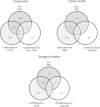Genetic diversity influences the response of the brain to developmental lead exposure
- PMID: 24913800
- PMCID: PMC4271117
- DOI: 10.1093/toxsci/kfu101
Genetic diversity influences the response of the brain to developmental lead exposure
Abstract
Although extrinsic factors, such as nutritional status, and some intrinsic genetic factors may modify susceptibility to developmental lead (Pb) poisoning, no studies have specifically examined the influence of genetic background on outcomes from Pb exposure. In this study, we used gene microarray profiling to identify Pb-responsive genes in rats of different genetic backgrounds, including inbred (Fischer 344 (F344)) and outbred (Long Evans (LE), Sprague Dawley (SD)) strains, to investigate the role that genetic variation may play in influencing outcomes from developmental Pb exposure. Male and female animals received either perinatal (gestation through lactation) or postnatal (birth through weaning) exposure to Pb in food (0, 250, or 750 ppm). RNA was extracted from the hippocampus at day 55 and hybridized to Affymetrix Rat Gene 1.0 ST Arrays. There were significant strain-specific effects of Pb on the hippocampal transcriptome with 978 transcripts differentially expressed in LE rats across all experimental groups, 269 transcripts differentially expressed in F344 rats, and only 179 transcripts differentially expressed in SD rats. These results were not due to strain-related differences in brain accumulation of Pb. Further, no genes were consistently differentially regulated in all experimental conditions. There was no set of "Pb toxicity" genes that are a molecular signature for Pb neurotoxicity that transcended sex, exposure condition, and strain. These results demonstrate the influence that strain and genetic background play in modifying the brain's response to developmental Pb exposure and may have relevance for better understanding the molecular underpinnings of the lack of a neurobehavioral signature in childhood Pb poisoning.
Keywords: development; hippocampus; lead; mRNA; strain differences.
© The Author 2014. Published by Oxford University Press on behalf of the Society of Toxicology. All rights reserved. For permissions, please email: journals.permissions@oup.com.
Figures




Similar articles
-
Strain specific effects of low level lead exposure on associative learning and memory in rats.Neurotoxicology. 2017 Sep;62:186-191. doi: 10.1016/j.neuro.2017.07.006. Epub 2017 Jul 16. Neurotoxicology. 2017. PMID: 28720388 Free PMC article.
-
Effects of developmental lead exposure on the hippocampal transcriptome: influences of sex, developmental period, and lead exposure level.Toxicol Sci. 2012 Sep;129(1):108-25. doi: 10.1093/toxsci/kfs189. Epub 2012 May 28. Toxicol Sci. 2012. PMID: 22641619 Free PMC article.
-
Effects of developmental lead exposure on the hippocampal methylome: Influences of sex and timing and level of exposure.Toxicol Lett. 2018 Jun 15;290:63-72. doi: 10.1016/j.toxlet.2018.03.021. Epub 2018 Mar 20. Toxicol Lett. 2018. PMID: 29571894 Free PMC article.
-
Environmental exposure to low-level lead (Pb) co-occurring with other neurotoxicants in early life and neurodevelopment of children.Environ Res. 2019 Oct;177:108641. doi: 10.1016/j.envres.2019.108641. Epub 2019 Aug 9. Environ Res. 2019. PMID: 31421445 Review.
-
Prenatal and early life lead exposure induced neurotoxicity.Hum Exp Toxicol. 2024 Jan-Dec;43:9603271241285523. doi: 10.1177/09603271241285523. Hum Exp Toxicol. 2024. PMID: 39340316 Review.
Cited by
-
Sex-Dependent Effects of Developmental Lead Exposure on the Brain.Front Genet. 2018 Mar 16;9:89. doi: 10.3389/fgene.2018.00089. eCollection 2018. Front Genet. 2018. PMID: 29662502 Free PMC article. Review.
-
Early life lead exposure causes gender-specific changes in the DNA methylation profile of DNA extracted from dried blood spots.Epigenomics. 2015;7(3):379-93. doi: 10.2217/epi.15.2. Epigenomics. 2015. PMID: 26077427 Free PMC article.
-
Clinical Evaluation of a Defined Zeolite-Clinoptilolite Supplementation Effect on the Selected Blood Parameters of Patients.Front Med (Lausanne). 2022 May 27;9:851782. doi: 10.3389/fmed.2022.851782. eCollection 2022. Front Med (Lausanne). 2022. PMID: 35712111 Free PMC article.
-
Different People, Different Outcomes: Assessing Genetic Susceptibility to Lead Exposures.Environ Health Perspect. 2016 Jul 1;124(7):A131. doi: 10.1289/ehp.124-A131. Environ Health Perspect. 2016. PMID: 27479021 Free PMC article. No abstract available.
-
Strain specific effects of low level lead exposure on associative learning and memory in rats.Neurotoxicology. 2017 Sep;62:186-191. doi: 10.1016/j.neuro.2017.07.006. Epub 2017 Jul 16. Neurotoxicology. 2017. PMID: 28720388 Free PMC article.
References
-
- Advisory Committee on Childhood Lead Poisoning Prevention. Low Level Lead Exposure Harms Children: A Renewed Call for Primary Prevention. 2012. Available at: http://www.cdc.gov/nceh/lead/ACCLPP/Final_Document_030712.pdf. Accessed May 19, 2014.
-
- Anderson D. W., Mettil W., Kidd S. K., Schneider J. S. Effects of developmental lead exposure on associative learning and memory are modified by sex, developmental window of exposure and level of exposure. The Toxicologist. 2012b;126:131. (Abstract)
-
- Bellinger D., Rappaport L. Developmental assessment and interventions. In: Harvey B., editor. Managing Elevated Blood Lead Levels Among Young Children: Recommendations from the Advisory Committee on Childhood Lead Poisoning Prevention. US Department of Health and Human Services, PHS; 2002. pp. 77–95.
-
- Centers for Disease Control (US) Preventing lead poisoning in young children: A statement by the Centers for Disease Control. Atlanta: CDC; 1991. Available at: http://www.cdc.gov/nceh/lead/Publications/books/plpyc/contents.htm. Accessed May 19, 2014.
Publication types
MeSH terms
Substances
Grants and funding
LinkOut - more resources
Full Text Sources
Other Literature Sources
Molecular Biology Databases

